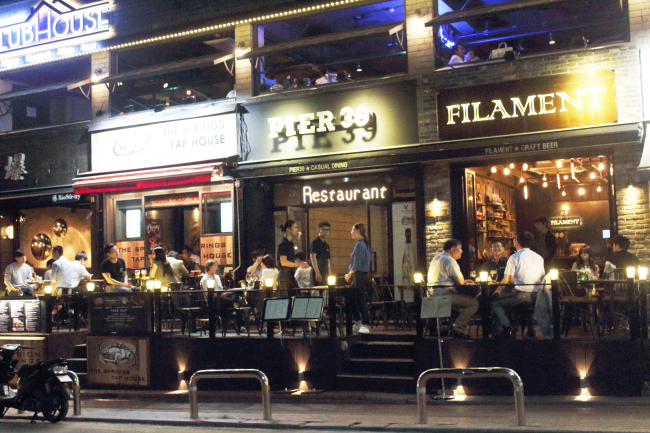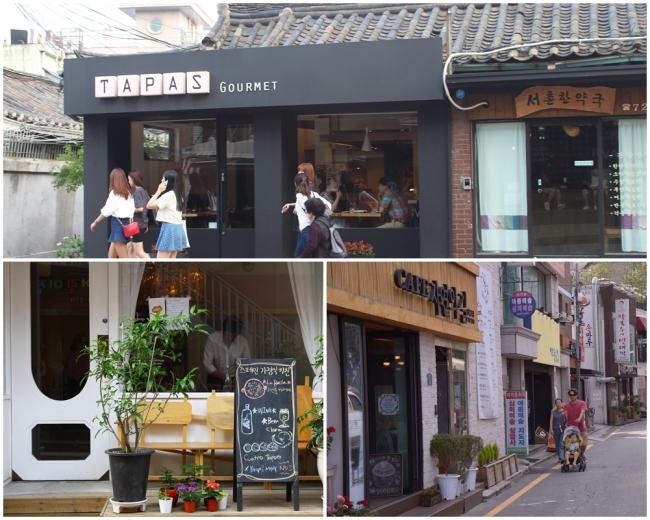[Weekender] The rise of ‘ordinary places’ as hot spots
‘I wouldn’t say the rise of these hot spots means that the existing popular places will die out. They might not be as refreshing as they were in the older days, though.’
By Korea HeraldPublished : June 26, 2015 - 20:23
On Wednesday afternoon, 23-year-old university student Kim Eun-young and her friend Lee Ha-young strolled the narrow alleys of Chebu-dong in Jongno-gu of Seoul.
They had a meal at the Tongin traditional market and sipped coffee while looking around the neighborhood, busily taking pictures. Instead of high-rises, the neighborhood is crammed with one- or two-story buildings, many in an early 20th century-style. The interior is decorated in European styles, with mostly bare wood or white and pastel shades.
“We sometimes hang around here. You get to see the old houses, little alleys with pretty products. The photos come out pretty and the prices aren’t so expensive, which makes the place quite attractive,” Kim said.
“We first visited here after reading blog postings depicting it as a hot spot. When you hear that kind of thing you need to be there, feel that atmosphere and be there to eat that food in the photo. I like being part of a big trend.”
They had a meal at the Tongin traditional market and sipped coffee while looking around the neighborhood, busily taking pictures. Instead of high-rises, the neighborhood is crammed with one- or two-story buildings, many in an early 20th century-style. The interior is decorated in European styles, with mostly bare wood or white and pastel shades.
“We sometimes hang around here. You get to see the old houses, little alleys with pretty products. The photos come out pretty and the prices aren’t so expensive, which makes the place quite attractive,” Kim said.
“We first visited here after reading blog postings depicting it as a hot spot. When you hear that kind of thing you need to be there, feel that atmosphere and be there to eat that food in the photo. I like being part of a big trend.”

Like Kim, thousands of people are now flocking to the places that were less popular in the past. While many tourists and Koreans still enjoy hanging at the conventional hot spots like Myeong-dong, Gangnam Station area, Garosugil or Hongdae, increasing numbers of Seoulites are beginning to seek out places that are trendy without being too familiar or popular.
When big-data analyst firm Tapa Cross studied a total of 130,000 articles on social media late last year, Seochon, Gyeongnidan-gil and Yeonnam-dong districts emerged as the next “happening places.”
About 85 percent of the mentions about those hot spots address positive reviews, mostly among women in their 20s and 30s, who are office workers or freelancing specialists with high payrolls. These new hot spots were mostly associated with keywords such as “good restaurants,” “hot cafes,” “dating spot,” “desserts,” “beauty salons,” “weekend,” and “good lunch.”
“There are no landmarks like the ones in the flashy and foreigner-frequented Myeong-dong in central Seoul, nor any glitzy bars and clubs there. But these places instead are soaked with a variety of cultural elements in every nook and cranny,” the company stated in its “2015 Saeng Saeng Trend.”
The report notes that the creation of a hot spot involves two very different desires -- to emulate others but at the same time to be different from them.
At first, the so-called trendsetters rush to a certain district trying to differentiate themselves from the crowd. But then the small buzz they create draws more people to the area, which eventually becomes a hot spot.

So what makes a happening place? Why has Seochon all of a sudden become a hot spot?
Kim Yong-hak, CEO of Tapa Cross, said that people have adverse reactions to the large commercial districts with franchise cafes and diners. In turn, these rising hot spots are rooted in the residential area with “a laid-back and somewhat friendly ambience.”
“The warm sunshine that you get when you enter that alley. The sound of a dog barking and baby crying: You don’t get to hear those too often in the city any more. This ambience shouts out the virtue of ordinary lives and just heals people who are sick and tired of rapid and stressed-out routines,” Kim said.
“I wouldn’t say the rise of these hot spots means that the existing popular places will die out. You still see people in Hongdae and Garosugil. They have just become very commercial with large franchise stores dominating the streets. They might not be as refreshing as they were in the older days, though,” he said.
By Bae Ji-sook (baejisook@heraldcorp.com)
-
Articles by Korea Herald




![[Herald Interview] 'Amid aging population, Korea to invite more young professionals from overseas'](http://res.heraldm.com/phpwas/restmb_idxmake.php?idx=644&simg=/content/image/2024/04/24/20240424050844_0.jpg&u=20240424200058)












![[KH Explains] Korean shipbuilding stocks rally: Real growth or bubble?](http://res.heraldm.com/phpwas/restmb_idxmake.php?idx=652&simg=/content/image/2024/04/25/20240425050656_0.jpg&u=)

